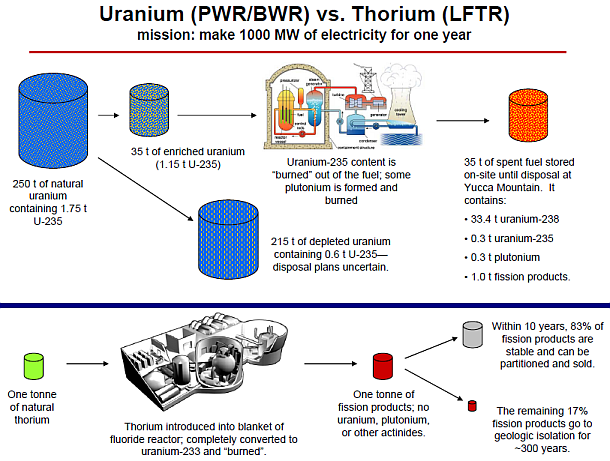Thorium (Th-232) is among the least radioactive materials (half-life 14 billion years). You can safely hold in your hand enough thorium to generate all the electricity you’ll use in your entire life.
Thorium can’t fission (it is fertile, not fissile), it must be converted into uranium before it can produce energy. This happens inside a LFTR, or some other types of molten salt reactor, with no fuel fabrication needed:
- Uranium in the reactor core releases neutrons,
- Thorium in a salt “blanket” around the core absorbs a neutron and decays in a few steps into U-233, which is fissile.
- Bubbling fluorine gas through the blanket salt converts Uranium (as UF4) to a gas (UF6), which is collected and converted back to UF4, then transferred into the fuel salt.

If we use reactors that convert thorium to U-233, we eliminate all need for enriching uranium. All U-233 is easily fissioned, in a thermal-spectrum or fast-spectrum reactor.
“Enriching uranium” is taking natural uranium, which is 0.7% U-235 (almost all U-238) and removing some of the U-238 to increase the percentage of U-235. In a thermal spectrum reactor, U-235 is much more likely to fission than U-238 is. Light Water Reactors and most other types of reactors currently used are “thermal-spectrum”, meaning the reactors use something, often water or graphite, to “moderate” or slow down the neutrons so they fission more uranium or plutonium instead of being absorbed. “Fast spectrum” reactors have a much better chance of fissioning U-238 instead of the neutrons being absorbed, so no enrichment is needed.
Fast Spectrum Molten Salt Reactors would most likely be used for fissioning “waste” from LWR, either at the LWR site or at the waste storage facility. FS-MSR would not use thorium, but instead, use the U-238 and Pu-239 in LWR waste. FS-MSR would use different salts than LFTR would use, requiring material testing for use with the different salt; less testing has been done. FS-MSR would have the same low-pressure operation, stable temperature, and easily controlled fission rate of any other MSR, with none of the instability concerns a fast-spectrum solid fueled reactor would have.
The Department of Energy is planning to destroy all our existing U-233, at a cost of $500 Million. This will be needed to start fission in the first molten salt reactors. “We are currently not supporting any projects that require U233 for testing. As such, the disposal of U233 will go forward.” – DoE. Molten Salt Reactors are one of the reactors proposed for the Generation IV International Forum, that the United States is part of, see DoE’s A Technology Roadmap for Generation IV Nuclear Energy Systems (2002). Sign the online petition to stop the destruction of U-233, http://wh.gov/EgnF.

Fission in the core (green) makes heat, which will turn turbines. Neutrons from fission convert thorium (blue “blanket”) to U-233; fluorination (left) 233UF6 separates U from Th and salt, then U goes into the reactor core. Fission products (right) are separated and stored.
The Department of Energy is planning to destroy all our existing U-233, at a cost of $500 Million. This will be needed to start fission in the first molten salt reactors. “We are currently not supporting any projects that require U233 for testing. As such, the disposal of U233 will go forward.” – DoE. Molten Salt Reactors are one of the reactors proposed for the Generation IV International Forum, that the United States is part of, for example see DoE’s A Technology Roadmap for Generation IV Nuclear Energy Systems (2002). Sign the online petition to stop the destruction of U-233, http://wh.gov/EgnF.
I am 15 years old and have gotten interested in the production, functions, testing, and conspiracy of all things relating to the lftr design. I am doing my NHD on it and would be honored if you would let me interview you.
I don’t know of any LFTR conspiracy, just normal fossil fuel companies protecting their own interests (any good nuclear reactor design would kill their business, so they made sure Congress picked LWR, against what the nuclear scientists and designers recommended).
Google Hangouts interview? Let me know times you might be available (including your time zone, I’ll convert).
I HUNDRED PERCENT AGREE ON THAT, U233 CAN BE USED IN REACTORS AND IT IS A FISSILE ISOTOP OF URANIUM. WHY TO WASTE U233 AND $500 MILLION? I THINK WE SHOULD KEEP IT FOR FUTURE REACTORS.
I AM AN EDUCATED PERSON FROM INDIA AND BELIEVE IN USING EVERYTHING INSTEAD OF WASTING IT. EVERY TIME WE WASTE THINGS WE CREATE POLLUTION ON THIS PLANET.